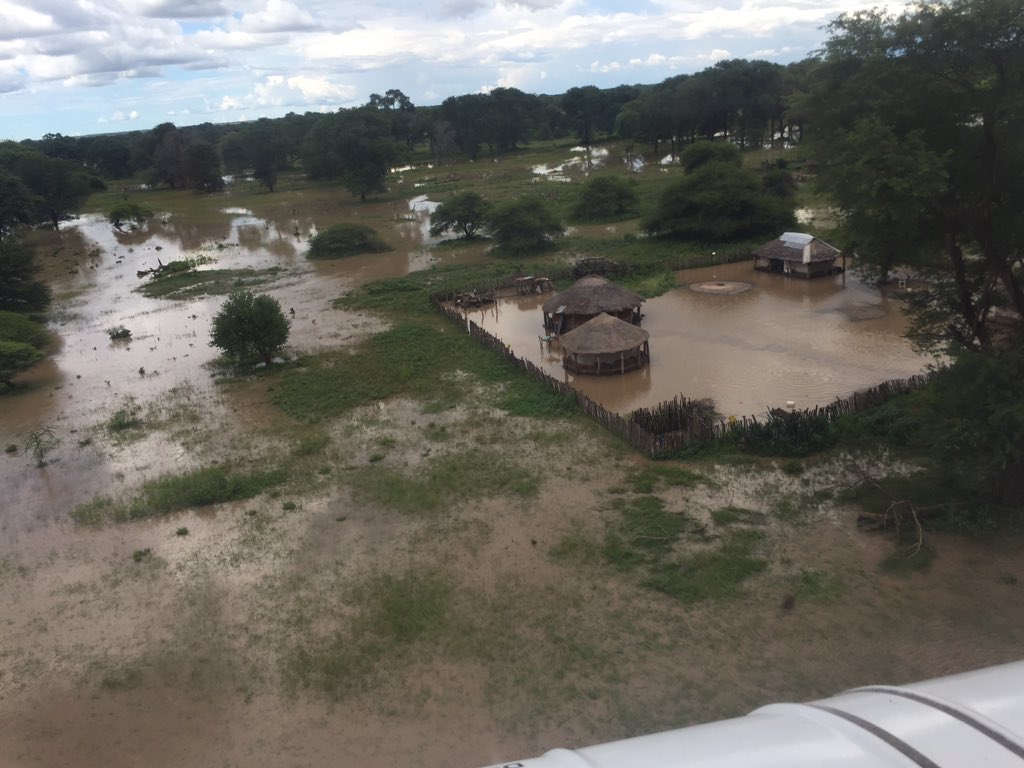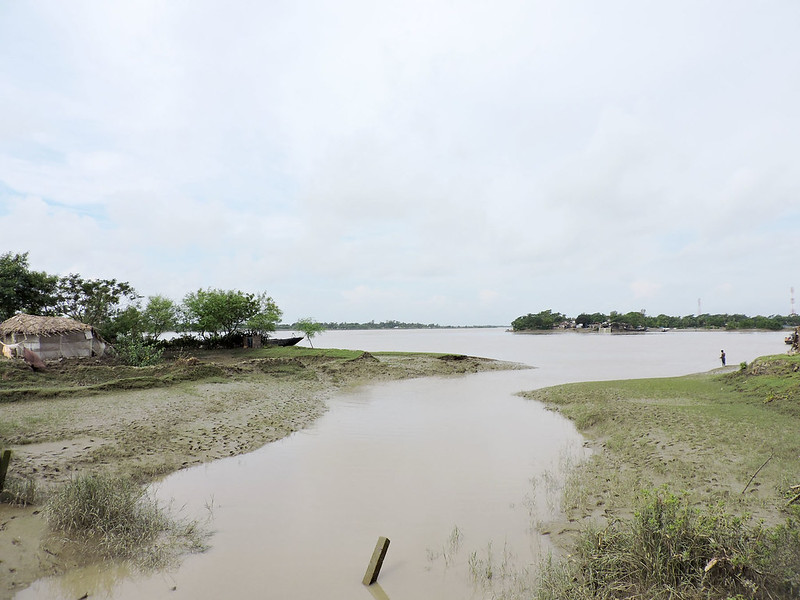Flooding is the overflowing or inundation of water over a usually dry surface. This overflowing can be brought about by a river spilling over its banks due to intense rainfalls, melting ice and snow, tsunamis and reservoir burst such as dams.
Varying factors increase the likelihood of flooding; physical factors such as surface porosity or human activities such as deforestation and building of concrete surfaces give way to floods.
Causes of Floods
Abnormal Rainfalls
Rainfall is the primary cause of most floods. Rainfall abnormalities are usually caused by long-term or short-term climate changes such as La Nina events and tropical storms.
Intense rainfalls can pave way for other causes such as increasing river discharge and volume causing it to overflow or burst dams.
Zimbabwe experienced high abnormal rainfalls in the 2016-2017 rain seasons which were caused by the Dineo cyclone.

River Overflow
River overflows are usually brought about by high rainfalls over a given period. Many factors will affect if the river overflows such as channel permeability.
Melting Ice
High global temperatures are causing polar icecaps and snow capped mountains to melt raising sea levels to rise and eventual floods especially in coastal areas.
Tsunamis
Earth movements in oceans can displace the ocean floor triggering huge waves of water called tsunamis. These massive waves of water can encroach and flood coastal areas, for example, The 2004 Boxing Day Tsunami caused massive damage around the coasts of The India Ocean.
Factors Affecting Flooding
There are physical as well as human (anthropogenic) factors which increase the rate of floods.
Nature of Surface
Impermeable surfaces hinder infiltration and encourage more runoff. In deserts baked rocky surfaces impedes water from infiltrating and promote more runoff. This causes flash floods in deserts. The same is true in ice-covered surfaces that create an impermeable layer which discourages infiltration.
In addition, porous soils such as sand favour infiltration over cohesive clays that impede infiltration and favour runoff.
Soil Moisture
Soils that are already filled with water tend to refuse infiltration of more water, thus any rain that falls on these soils will not infiltrate therefore runs off on the surface (saturated overland flow)
Relief
Low-lying flat areas are more susceptible to flooding as more water accumulates instead of being transported and removed by runoff. The accumulation is highly increased if the area is impermeable and the soil is already saturated.
Vegetation
Densely vegetated catchments are less likely to experience flooding as more water is intercepted from reaching the surface than sparsely vegetated catchments. In addition, plant roots absorb water and encourage infiltration.
Drainage Basin Morphology
Elongated drainage basins with lots of tributaries are likely to experience floods as the volume of water is high. In contrast, large drainage basins may not experience flooding as the lag time tend to be long. Conversely, small catchments can be prone to flooding as they have short lag times.
However, drainage densities large or small both can experience flooding. This will depend on varying factors in the drainage basin such as ground porosity and gradient.
If a drainage basin is small but characterised by flat terrains, permeable surfaces or dense vegetation, the basin is likely to inexperience flooding or if a basin is long but has impermeable surfaces, sparse vegetation or steep slopes, that basin is more likely to flood.
Human Activities
Deforestation
The lack of trees means that more water readily runs off on the surface without being intercepted.
In addition, a lack of trees results in more soil movement as they are no roots to bind the soil together. The loose soil can be carried and deposited in rivers and cause siltation. With lots of sediments, the river has no choice but to overflow its banks.
Urbanisation
As lots of people are moving into urban areas, the need for more roads and pavements result in more flooding. Concrete and asphalt surfaces are impermeable thus impedes infiltration and encourage more runoff on the surface.
Mining
Mining results in high amounts of unconsolidated soil which can find its way to rivers causing siltation, choking the river and eventually river flooding.
Furthermore, mining involves the removal of trees which again encourages high risks of flooding. Small scale miners mining for gold along rivers can also cause siltation which can lead to flooding.

Agriculture
Farming can involve the removal of vegetation which contributes to flooding. In addition, overgrazing results in sparse vegetation and unconsolidated soil which can be washed away into rivers (siltation).
Farming methods like stream bank cultivation(farming along the banks of a river) result in the silting of rivers as more soil readily reaches the river.
Dumping
Commercial and domestic dumping in rivers can also lead to flooding as waste and sediments build up leading to siltation and eventually flooding.
River Modification
Channel straightening, channel diversion, artificial levees can have grave consequences, even though its done in order to reduce floods.
For example, straightening a river in a particular area may reduce flooding in that area, but discharge increases which can cause floods downstream. Letting the river flow naturally can minimise flooding than artificially modifying it.

Effects of Floods
Floods impose devastating impacts on both humans and the environment. Furthermore, the economy is crippled as a result of floods. The most disastrous effects are experienced in LEDCs due to the inability to cope and the lack of advanced technology to implement protective and mitigatory measures.
Social Effects
- Loss of livelihoods e.g the 2016-2017 floods in Zimbabwe claimed nearly 250 lives and injured 128 people.
- Settlements are destroyed.
- Endemics such as typhoid or cholera resulting from sewage bursts.
- School drop-out.
- Separation of families.
Economic
- Infrastructure such as road networks are cut-off rendering them inaccessible
- Buildings, schools and hospitals are destroyed. Unemployment can rise sharply
- Dam or oil plant bursts.
- Power lines are destroyed.
- Farming lands are destroyed.
- Damage to tourist sites.
Environmental
- Natural ecosystem is destroyed
- Silting of rivers as water drawn back to the river carries large amounts of sediments
- Animal habits and aquatic life is destroyed.
Even though floods pose some of the worst effects, they are also beneficial. Flood plains create some of the most fertile lands. Floods can create wetlands for new animal species.
Preventing and Mitigating Floods
Flood prevention includes soft and hard engineering techniques. Soft engineering techniques involve natural ways of preventing floods e.g., deforestation while hard engineering mainly consists of artificial practices, e.g., dam constructions or artificial levees.
Hard Engineering Techniques
Dam Construction
Dams collect water from upstream and impede discharge downstream. Water is allowed to pass through a controlled point (floodgates).
However, dams are expensive to construct and require constant monitoring. Dam construction means an area has to be cleared for the dam which can destroy the natural ecosystem. Furthermore, if the dam is to burst, widespread floods will again be experienced.
Artificial Levees
Humans can build raised embankments made of concrete called levees which block water from overflowing and retain it in the channel. In contrast, levees can occur naturally as sediments are deposited along the banks of a river.
Wing Dykes
Slats placed in a river channel at right angles or adjacent to the banks which causes sediments to collect behind them. This improves the flow of the water at the particular area where wing dykes are placed.

Source:Alex Jackson under the Creative Commons Attribution-NonCommercial 4.0 Int license
River Diversion
This involves the creation of new channels in which a river permanently flows . This helps to divert water from areas prone to flooding. However, this can lead to flooding in areas where the diverted stream passes.
Building High and Wider bridges
Higher and wider bridges cause water to flow freely and reduce the accumulation of sediments. Too much sediment chocks a river and can cause flooding.
Channel Straightening
This improves river flow by removing and preventing landforms like meanders and pools which facilitate sediment deposition.
Building Permeable Surfaces
Permeable surfaces encourage water to infiltrate and reduce high amounts of runoff. In urban areas, this means creating “green zones” which are natural unbuilt areas such as parks.
Storm Drains
Constructing storm drains helps by removing excess water on the surface.
Soft Engineering Techniques
Afforestation
Planting trees help to intercept more rainwater and therefore reduce excess runoff. In addition, plant roots absorb water from the surface reducing runoff. Furthermore, plant roots stabilise soil movement which reduces the possibility of soil entering rivers.
Dredging
This involves removing excess sediments within the river improving its flow and lessening flooding. However, dredging itself if not done properly can also cause sedimentation.
Isolate Flood Prone Areas
Isolating flood-prone areas help reduce loss of lives and damage and can be less costly than having to establish or build expensive structures such as dams. However, finance will be needed to build new houses for the evacuated people.
Placing Dumping Restrictions
Imposing laws, jail penalties and restrictions on waste dumping ensures that rivers are free from being choked by sediments and flow is improved.
Improving Standards of Living
Improving people’s standards of living through education on better farming techniques, settlements, allocation of resources and land etc will help to mitigate some causes which lead to floods.
River Restoration
Sometimes it is better to restore a river to its natural course. Modifications such as river straightening and diversion may cause some long-term river problems. As such letting a river take its natural route may lessen the likelihood of flooding.